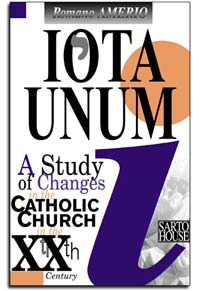|

|
 Contents Contents
Romano Amerio
Notice To The Reader
Iota Unum
Chapter I: The Crisis
- Methodological and linguistic definitions.
- Denial of the crisis.
- The error of secondary Christianity.
- The crisis as failure to adapt.
- Adapting the Church's contradiction
of the world.
- Further denial of the crisis.
- The Pope recognizes the loss
of direction.
- Pseudo-positivity of the crisis.
False philosophy of religion.
- Further admissions of a crisis.
- Positive interpretation of the
crisis. False philosophy of religion.
- Further false philosophy of
religion.
Chapter II: Historical Sketch: The
Crises Of The Church
- The crises of the Church: Jerusalem
(50 A.D.).
- The Nicene crisis (325 A.D.).
- The deviations of the Middle
Ages.
- The crisis of the Lutheran secession.
The breadth of the Christian ideal.
- Further breadth of the Christian
ideal. Its limits.
- The denial of the Catholic principle
in Lutheran doctrine.
- Luther's heresy, continued. The
bull Exsurge Domine.
- The principle of independence
and abuses in die Church.
- Why casuistry did not create
a crisis in the Church.
- The revolution in France.
- The principle of independence.
The Auctorem Fidei.
- The crisis of the Church during
the French Revolution.
- The Syllabus of Pius
IX.
- The spirit of the age. Alexander
Manzoni.
- The modernist crisis. The second
Syllabus.
- The pre-conciliar crisis and
the third Syllabus.
- Humani Generis
(1950).
CHAPTER III: The Preparation of The Council
- The Second Vatican Council. Its
preparation.
- Paradoxical outcome of the Council.
- Paradoxical outcome of the Council,
continued. The Roman Synod.
- Paradoxical outcome of the Council,
continued. Veterum Sapientia.
- The aims of the First Vatican
Council.
- The aims of Vatican II. Pastorality.
- Expectations concerning the Council.
- Cardinal Montini’s forecasts.
His minimalism.
- Catastrophal predictions.
CHAPTER IV: The Course of The Council
- The opening address. Antagonism
with the world. Freedom of the Church.
- The opening speech. Ambiguities
of text and meaning.
- The opening speech. A new attitude
towards error.
- Rejection of the council preparations.
The breaking of the council rules.
- The breaking of the Council’s
legal framework, continued.
- Consequences of breaking the
legal framework. Whether there was a conspiracy.
- Papal action at Vatican II.
The Notapraevia.
- Further papal action at Vatican
II. Interventions on mariological doctrine. On missions.
On the moral law of marriage.
- Synthesis of the council in the
closing speech of the fourth session. Comparison with St.
Pius X. Church and world.
CHAPTER V: The Post-Conciliar Period
- Leaving
the Council behind. The spirit of the Council.
-
Leaving the Council behind. Ambiguous character of the conciliar
texts.
- Novel
hermeneutic of the Council. Semantic change. The word “dialogue.”
- Novel
hermeneutic of the Council, continued. “Circiterisms.” Use
of the conjunction “but.” Deepening understanding.
- Features
of the post-conciliar period. The universality of the change.
- The
post-conciliar period, continued. The New Man. Gaudium
et Spes 30. Depth of the change.
-
Impossibility of radical change in the Church.
- The
impossibility of radical newness, continued.
- The
denigration of the historical Church.
- Critique
of the denigration of the Church.
-
False view of the early Church.
CHAPTER VI: The Post-Conciliar Church, Paul VI
- Sanctity of the Church. An apologetical
principle.
- The
catholicity of the Church. Objection. The Church as a principle
of division. Paul VI.
- The unity of the post-conciliar
Church.
- The Church disunited in the hierarchy.
- The Church disunited over Humanae
Vitae.
- The Church disunited concerning
the encyclical, continued.
- The Dutch schism.
- The renunciation of authority.
A confidence of Paul VI.
- An historic parallel. Paul VI
and Pius DC
- Government and authority.
- The renunciation of authority,
continued. The affair of the French catechism.
- Character of Paul VI. Self-portrait.
Cardinal Gut.
- Yes and no in the post-conciliar
Church.
- The renunciation of authority,
continued. The reform of the Holy Office.
- Critique of the reform of the
Holy Office.
- Change in the Roman Curia. Lack
of precision.
- Change in the Roman Curia, continued.
Cultural inadequacies.
- The Church’s renunciation in
its relations with states.
- The revision of the concordat,
continued.
- The Church of Paul VI. His speeches
of September 1974.
- Paul VI’s unrealistic moments.
CHAPTER VII: The Crisis of the Priesthood
- The defection of priests.
- The canonical legitimation of priestly defections.
- Attempts to reform the Catholic priesthood.
- Critique of the critique of the Catholic priesthood. Don Mazzolari.
- Universal priesthood and ordained priesthood.
- Critique of the saying “a priest is a man like other men."
CHAPTER XV: Pyrrhonism
- Theological setting of the argument.
- Pyrrhonism in the Church. Cardinals
Léger, Heenan, Alfrink and Suenens.
- The discounting of reason.
Sullivan. Innovators’ rejection of certainty.
- The discounting of reason, continued.
The Padua theologians. The Ariccia theologians. Manchesson.
CHAPTER XVI: Dialogue
- Dialogue and discussionism in
the post-conciliar Church. Dialogue in Ecclesiam Suam.
- Philosophy of dialogue.
- Appropriateness of dialogue.
- The end of dialogue. Paul VI.
The Secretariat for Non-Believers.
- Whether dialogue is always an
enrichment.
- Catholic dialogue.
CHAPTER XVII:
|
Courtesy of the Angelus
Press, Kansas City, MO 64109
Only select chapters are presented here.
To buy the whole book please click
here
|


![]()
![]()